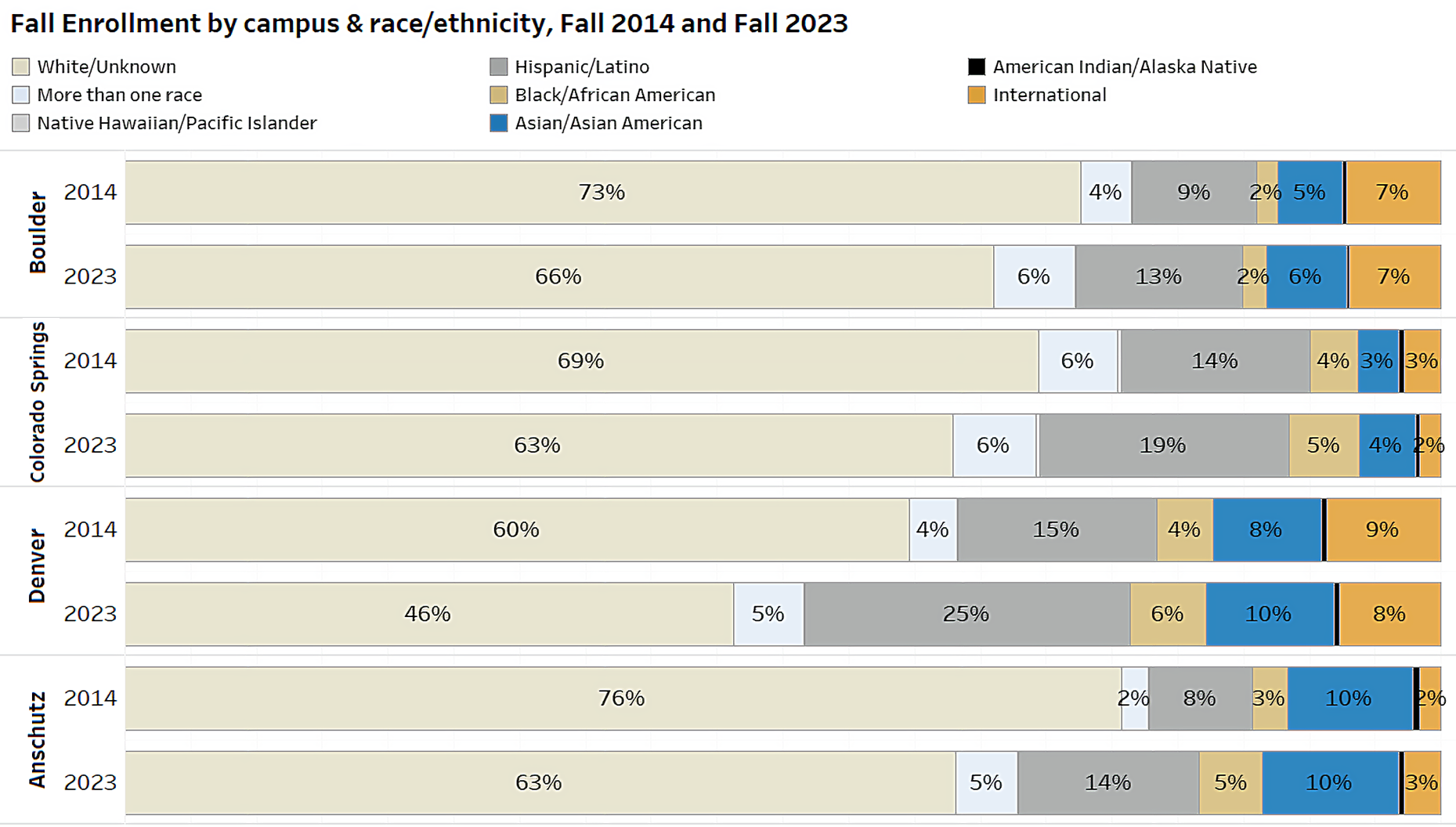University of Colorado Diversity Report highlights growing inclusivity
A new diversity report tells a story of progress and opportunity across the University of Colorado system, with indications of significant strides toward fostering a more inclusive and diverse academic environment. The 2023-24 Diversity Report’s data also shows the need for continued commitment to achieving goals for diversity, equity, inclusion and accessibility (DEIA).
As part of CU’s strategic plan, each campus has reported data on student and employee diversity to the Board of Regents for the past two years, promoting transparency and accountability throughout the university. The updated Regent Policy 10.A from September 2023 reinforces the university's commitment to creating diverse and inclusive environments.
Over the past decade, CU's student population has become increasingly diverse. The report notes a 51% rise in students of color since 2014.
In Fall 2023, students of color made up 33% of the student body, with Hispanic or Latino students comprising 16% of the enrollment. Specifically, 19% of students at UCCS and 25% at CU Denver are Hispanic or Latino. While CU Boulder’s student body is 13% Latino, those 4,938 students represent 45% of CU’s total Latino population. The report also tracks other demographics such as students who are first generation, Pell grant recipients and veterans, among other identities.
Click image to enlarge or view online
CU President Todd Saliman emphasized the university's dedication to inclusivity, acknowledging the progress made while recognizing the need for continued efforts.
“We are committed to creating an inclusive environment where all students, faculty and staff can thrive,” Saliman said. “I want to extend my heartfelt gratitude to everyone who works tirelessly to advance these efforts. Your dedication is helping to build a brighter, more inclusive future for our university community.
“While impressive progress has been made, ongoing work is needed to achieve our goals for a more inclusive and equitable community. I’m glad we are headed in the right direction."
CU Denver l Anschutz has achieved the status of Hispanic-Serving Institution (HSI) and Asian American and Native American Pacific Islander-Serving Institution (AANAPISI). The university regained its HSI status in May 2024, notably graduating twice as many Latinx engineers as the national average. UCCS is recognized as an emerging HSI, with 19% Hispanic or Latino student enrollment, progressing toward the 25% threshold needed for HSI designation.
To enhance the sense of belonging among students and employees, CU leverages data from the Campus and Workplace Culture (CWC) and other surveys. These efforts aim to improve student retention and support academic success.
While the diversity report tracks data and strategies from the past year, it does not account for recent external challenges and impacts such as the Supreme Court decisions on graduate admissions, issues with the FAFSA system, and the uncertain future of DACA. Despite these hurdles, CU remains committed to increasing diversity among faculty, staff and students to better reflect Colorado’s demographics.
This spring, CU advocated for legislation supporting students from varied economic backgrounds. The recent CU-led legislation that provides tax incentives for Colorado families earning up to $90,000 annually underscores CU’s dedication to affordability and accessibility. Though not reflected in this year’s report, these funding efforts aim to support Colorado students and encourage their enrollment at CU in the coming years.
President Saliman regularly articulates his goal of representing the diversity of Colorado. Ongoing outreach efforts aimed at strengthening relationships across the state are intended to foster more inclusive campus communities.
The report provides comprehensive data on applications and enrollment:
- Applications: CU received 29,381 applications for Fall 2023, an 81% increase since Fall 2014. Of these, 14,214 were from students of color, making up 48% of total applications.
- Enrollment: In Fall 2023, 22,446 students of color were enrolled, representing 33% of the student population. This includes 11,061 Hispanic or Latino students, who make up 16% of total enrollment.
- Degrees awarded: CU awarded 11,456 bachelor's degrees and 6,477 graduate degrees in 2022-23. Notably, 31% of bachelor’s degrees and 23% of graduate degrees were awarded to students of color, reflecting significant increases over the past decade.
Retention and graduation rates show positive trends:
- Retention rates: CU Boulder has a 90% first-to-second-year retention rate for white students and 87% for students of color. CU Denver reports higher retention rates for students of color (73%) compared to white students (68%). UCCS retention rates are 69% for white students and 65% for students of color.
- Graduation rates: CU Boulder has a 76% six-year graduation rate for white students and 73% for students of color. At CU Denver, the graduation rate for students of color (48%) is slightly higher than that for white students (45%). UCCS graduation rates are 48% for white students and 40% for students of color.
Diversity among CU’s faculty and staff has also improved:
- Non-faculty staff: 29% of non-faculty staff are from non-white, non-international race/ethnicity categories, including 26% at CU Boulder, 30% at CU Denver, 24% at UCCS and 31% at CU Anschutz.
- Faculty: 19% of all faculty are from non-white, non-international race/ethnicity categories. This percentage is up at all campuses since 2014 and includes 22% at CU Boulder, 22% at CU Denver, 19% at UCCS and 18% at CU Anschutz.
For more detailed information, the full report is available on the CU Office of Diversity, Equity and Inclusion website. Interactive data from the report is available here.


